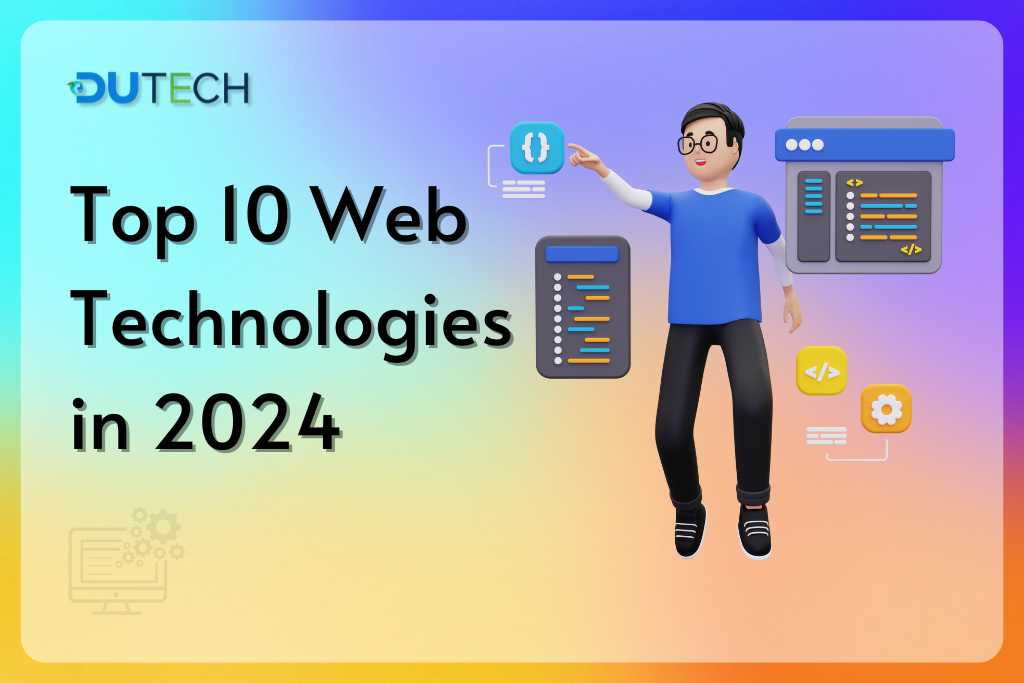Web development looks like a streamlined process for developing any website, but it consists of complex coding and the fusion of various web technologies. This intricate procedure delves into the dynamics of web technologies. To create a unique but user-friendly experience, web developers have to use many different technologies and integrate them so that a website serves its purpose of educating, persuading, leading generation, branding, customer relations, and business generation.
This comprehensive blog will explore the top 10 web technologies you can use in 2024!
What are Web Technologies?
The collection of tools, languages, and frameworks of HTML, CSS, JavaScript, databases, and server-side scripting languages are known as web technologies. Web technologies are constantly evolving, and web developers have to master them for fluent front-end development, back-end development, and full-stack development.
The Significance of Web Technologies
Using the latest and most updated web technologies is crucial, as it impacts not only the user experience of the website but also its performance. Working on outdated web technologies can slow down the website’s speed and contribute to a poor user experience, ultimately resulting in low search engine rankings. To create a compelling website that meets modern standards, web developers must stay ahead of the curve to stay updated with the latest web technologies and tools.
Top 10 Web Technologies in 2024
1. React
In recent years, React has become one of the most popular web development tools. React, a JavaScript library originally developed by Facebook is now the most preferred choice for creating versatile user interfaces for websites and web applications.
React is popular for its reusable UI components, faster-rendering speed and component-based architecture. The vast ecosystem of third-party libraries and tools empowers web developers to navigate through and build complex web applications.
2. Angular
Launched by Google, Angular is a web development framework that has gained popularity due to its powerful data binding and dependency injection features. Though it is a little bit trickier at first, once you get the hang of it, it is the easiest way to develop intricate web applications.
3. Vue.js
Vue.js is another accelerating JavaScript web development framework that developers love for its simplicity and ability to create lightweight websites and web applications. Vue.js leverages the ecosystem of third-party libraries and tools that enable developers to create web applications that are easy to maintain and scale.
4. Node.js
Node.js is a server-side JavaScript runtime that allows developers to use JavaScript on the server side to program saleable and high-performance web applications. With its vast ecosystem of third-party libraries, tools, and ability to handle a huge number of simultaneous connections, Node.js is the ideal tool for developing real-time web applications.
5. GraphQL
To build more scalable and maintainable web applications, website development companies are pivoting to GraphQL. Its query language for APIs offers efficient, powerful, and flexible options to communicate with APIs.
The ability to create complex websites and web applications with the help of the vast ecosystem of tools and libraries makes it one of the most advanced and popular development tools.
6. Jamstack
It is the latest web development architecture that uses static assets and pre-built markup. The higher rendering speed, enhanced security, ecosystem of tools and libraries, and rapid scalability make it one of the top choices for building complex and high-performance web applications and websites.
7. Progressive Web Apps (PWA)
PWA is a growing web application design that delivers a native app-like experience on mobile devices. Features like offline workability, push notifications, and adding app icons to the home screen of the devices with a responsive user experience enable the user to access the web application without downloading and installing it on mobile devices. This technology is pioneering for businesses that want to give their customers an app-like experience without the need to download it from the app store.
8. Single Page Applications (SPA)
Single Page Applications emphasize loading a single HTML page, which gets updated according to how users interact with the application. Apart from the traditional approach of reloading the whole page from the server, SPA works on the model of client-side rendering to update the webpage according to the user’s interest. This approach results in a quick and responsive experience for users, as the page does not load whenever the user uses the application. The uses of this technology are revolutionizing industries like e-commerce and social media platforms.
9. Headless CMS
Headless CMS is a content management system that differentiates content management functions from the presentation layer of a website or application. Headless CMS allows the storage and management of content separately from the front-end presentation layer. This capability of this technology allows the developer to use any front-end development technology and framework to create a unique application. Headless CMS and its applications are benefiting the creation and management of content-based applications like news portals, blogs, and e-commerce sites.
10. WebAssembly
WebAssembly is a potent tool that allows the developer to run compiled code in web browsers, whether it is in C++ or Rust. Developers can write code in any language, and the same coding can be arranged in WebAssembly, which directly runs in the web browser. This technology leverages the full potential of web development and helps in developing intricate and complex websites or applications.
Conclusion
In conclusion, web development is a complex field that relies on ever-evolving technologies. Mastering these top 10 trends in 2024, from React to WebAssembly, will empower you to create exceptional websites and web applications that are both user-friendly and high-performing. By staying ahead of the curve, you can ensure your web projects meet modern standards and deliver a compelling user experience.

